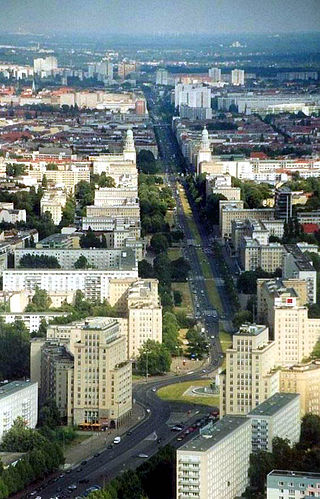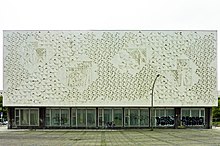
East Berlin was the partially recognised capital city of East Germany (GDR) from 1948 to 1990, although it was recognised by the Three Powers as the Soviet occupation sector of Berlin, established in 1945. The American, British, and French sectors were known as West Berlin. From 13 August 1961 until 9 November 1989, East Berlin was separated from West Berlin by the Berlin Wall. The Western Allied powers did not recognize East Berlin as the GDR's capital, nor the GDR's authority to govern East Berlin. On 3 October 1990, the day Germany was officially reunified, East and West Berlin formally reunited as the city of Berlin.

Hans Modrow was a German politician best known as the last communist premier of East Germany.

The Palace of the Republic was a building in Berlin that hosted the Volkskammer, the parliament of East Germany, from 1976 to 1990.
Articles related to East Germany include:

The culture of East Germany varied throughout the years due to the political and historical events that took place in the 20th century, especially as a result of Nazism and Communism. A reflection on the history of arts and culture in East Germany reveals complex relationships between artists and the state, between oppositional and conformist art. In four decades, East Germany developed a distinct culture and produced works of literature, film, visual arts, music, and theatre of international acclaim. Popular culture specialities included among others a high popularity of nudism in Eastern Germany.

Karl-Marx-Allee is a monumental socialist boulevard built by the GDR between 1952 and 1960 in Berlin Friedrichshain and Mitte. Today the boulevard is named after Karl Marx. It should not be confused with the Karl-Marx-Straße in the Neukölln district of Berlin.
Stalin-Allee is a German short film by director Sven Boeck.

Margot Honecker was an East German politician and influential member of the country's Communist government until 1989. From 1963 until 1989, she was Minister of National Education of the German Democratic Republic (GDR). She was married to Erich Honecker, leader of East Germany's ruling Socialist Unity Party from 1971 to 1989 and concurrently from 1976 to 1989 the country's head of state.

Coming Out is a 1989 East German film directed by Heiner Carow and written by Wolfram Witt which deals with the lead character, a high school teacher, "coming out" and accepting himself as gay. It was the last East German film released to the public prior to the German reunification and one of the last films made by DEFA, the East German state film studio, and the only gay-themed feature film that it made.

The Berlin International Film Festival, usually called the Berlinale, is a major international film festival held annually in Berlin, Germany. Founded in 1951 and originally run in June, the festival has been held every February since 1978 and is one of Europe's "Big Three" film festivals alongside the Venice Film Festival held in Italy and the Cannes Film Festival held in France. Furthermore, it is one of the "Big Five", the most prestigious film festivals in the world. The festival regularly draws tens of thousands of visitors each year.

Mitte is a central section of Berlin, Germany, in the eponymous borough of Mitte. Until 2001, it was itself an autonomous district.
Roland Gräf was a German cinematographer, film director and screenwriter. In 1982 his film "Märkische Forschungen" won the Findling Award at the National Feature Film Festival of the GDR in Karl-Marx-Stadt. His 1986 film The House on the River was entered into the 36th Berlin International Film Festival. Three years later, his film Fallada: The Last Chapter was entered into the 39th Berlin International Film Festival. In 1991, his film The Tango Player was entered into the 41st Berlin International Film Festival.

Hands Up or I'll Shoot is an East German crime comedy film directed by Hans-Joachim Kasprzik, who wrote the script along with Rudi Strahl. Rolf Herricht starred as officer Holms.

The Berlin Stalin statue was a bronze portrayal of the Soviet leader Joseph Stalin. A Komsomol delegation had presented the sculpture to the East Berlin government on the occasion of the Third World Festival of Youth and Students in 1951. The monument was formally dedicated on 3 August 1951 after temporary placement at a location on a newly designed and impressive boulevard, Stalinallee, being constructed at the time in what was then the Berlin district of Friedrichshain. Stalin monuments were generally removed from public view by the leadership of the Soviet Union and other associated countries, including East Germany, during the period of De-Stalinization. In Berlin the statue and all street signs designating Stalinallee were hastily removed one night in a clandestine operation and the street was renamed Karl-Marx-Allee and Frankfurter Allee. The bronze sculpture was smashed and the pieces were recycled.

Edmund Collein was an East German architect and urban planner. He is also known for his photography while studying at the Bauhaus art school.

The Kino Babylon is a cinema in the Mitte neighbourhood of Berlin and part of a listed building complex at Rosa-Luxemburg-Platz opposite the Volksbühne theatre. The building was erected 1928–29. It was designed by the architect Hans Poelzig in the Neue Sachlichkeit style. In 1948 the theatre was heavily renovated and served afterward as a speciality cinema for the German Democratic Republic. After the auditorium was closed because of the danger of collapse, it was restored from 1999 to 2001 in accordance with conservation guidelines. In 2002 the restoration was awarded the "German Award for Monument Protection".

Josef Kaiser was an East German urban architect associated, in particular, with a number of the country's more high-profile building projects during the 1950s and 1960s. In 1946, following serious illness, he embarked on a career as an operatic tenor: five years later he returned to architecture.

The East German Republic Day Parade of 1989 was a parade on Karl-Marx-Allee in East Berlin on 7 October 1989 commemorating the 40th anniversary of the establishment of East Germany. This was the last East German Republic Day Parade and the last major East German political event with the regime falling mere weeks later. In Germany, this parade is remembered as the end of "the great period of military parades".

Horst Stechbarth was an East German politician and high-ranking military officer in the National People's Army, holding the rank of Generaloberst. He was the Chief of the NVA's Landstreitkräfte and the ex officio Deputy Minister of Defense of the GDR. He was also a member of the Politbüro of the Central Committee of the ruling Socialist Unity Party of Germany (SED).





















